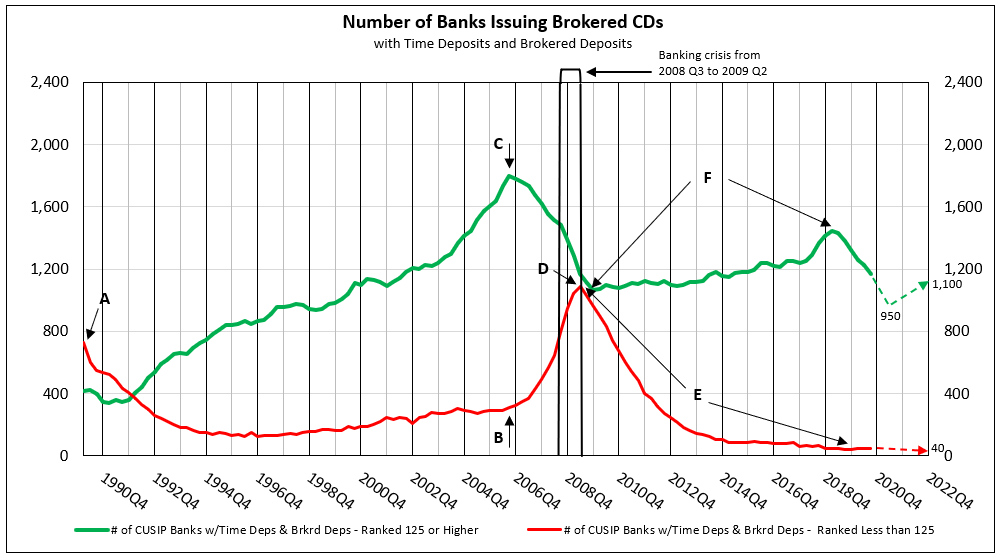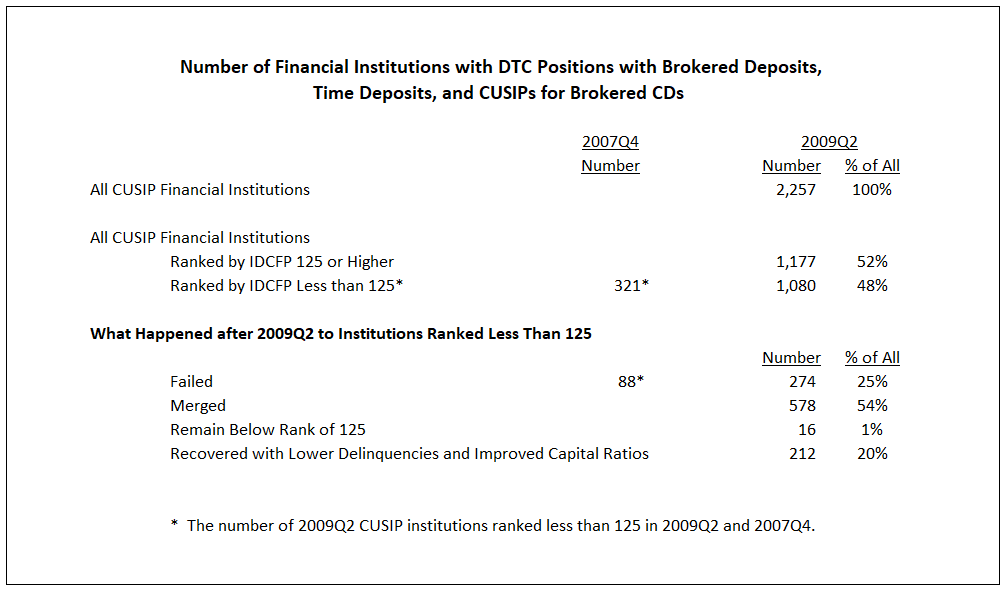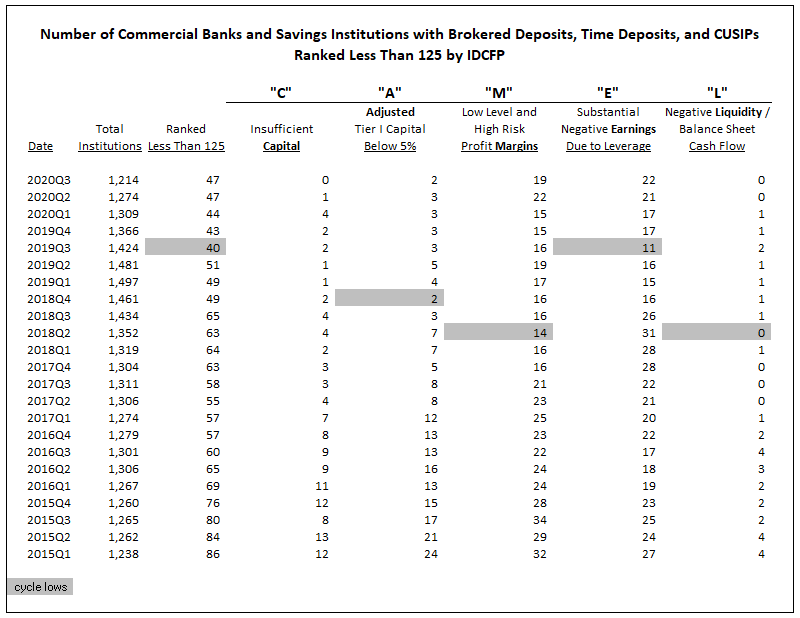Our Remarkable Record Predicting Bank Failure and Recovery
Updated for 3rd Quarter 2020 ranks
IDC Financial Publishing's Record in History
From 1990 to 2018, there were 1,419 failures of banks. Of these, 90% (1,271 banks) were ranked less than 125 by IDC Financial Publishing (IDCFP) up to 17 months before failure. Further, 73% (1,033 banks) were rated less than 125 by IDCFP up to 29 months before a collapse. The Washington State Department of Financial Institutions has listed on their website “IDC has a remarkable track record of identifying deteriorating or improving performance months, and sometimes years, before it becomes apparent to other ranking companies.” Using the group of banks which issued brokered CDs, IDCFP’s ranks not only predicted bank failure, but also forecast the larger banking crisis of 2008 to 2009.
IDCFP’s CAMEL safety ratings of banks, savings institutions, credit unions range from 300 (the top grade attainable) to 1 (the lowest). From the early 1990’s, through today, institutions using our CAMEL ranks determined that ranks less than 125 were deemed below investment grade.
In Chart I, the red line plots the numbers of banks with an IDCFP rank less than 125. The number of these high-risk banks reached peak levels in the early 90’s (A), following the banking crisis in the late 80’s. The number of high-risk banks issuing brokered CDs then declined and stabilized at low levels until 2006.
Chart I

IDCFP’s Ranks Forecast the Banking Crisis of 2008 - 2009
In early 2006, the number of banks with an IDCFP rank below 125 began to accelerate (B). At the end of that same year, banks with a rank of 125 or higher, peaked at 1,800 (C) and began a decline. Together, the change in the numbers of these banks forecast, with a 2-year lead time, the crisis of 2008-2009. The peak and decline of the red line in Chart I illustrate the end of the banking crisis, and the beginning of the resolution of high-risk banks.
The second quarter of 2009 produced the largest number of institutions with a safety rank below 125, reaching peak level (D), also predicting the end of the crisis with a 2-year lead time. The total number of banks with brokered deposits, time deposits and CUSIP numbers for outstanding CDs numbered 2,257. Out of this total, 1,177 (52%) banks were ranked 125 or higher, and 1,080 (48%) were ranked less than 125.
Out of the 1,080 high-risk banks, 274 (25%) failed, 578 (54%) merged, 16 (1%) currently remain below investment grade, and 212 (20%) recovered, attaining a rank of 125 or above due to reduced delinquencies or improved capital ratios as of the 3rd quarter of 2020 (see Table I).
Table I

Table II below shows the number of bank failures continued to accelerate until June 2010, following the peak of institutions ranked less than 125 in 2009 by IDCFP.
Table II

Select Bank Mergers Improve Financials
From June 2009 to September 2020, a total of 578 institutions merged. Of these, 403 institutions merged into surviving institutions ranked 125 or higher. The low institution ranks were published prior to the merger, therefore a measure of high risk. As a result, the merged institutions not only survived, but also benefited. Our rank of those banks, with CDs in existence or to be issued, rose from below to above investment grade.
The Importance of IDCFP’s Ranks to Monitor Institutions Post-Banking Crisis
The demand for our financial institution ranks measuring the safety and soundness of banks continued strong from 2008 and post-crisis, as banks continued to fail and merge with higher-rated surviving institutions.
- As of June 30, 2009, banks and savings institutions ranked less than 125 by IDCFP totaled 1080, or 48% of all ranked institutions (see Table I).
- Of the 1080 institutions, only 212, or 20% of institutions ranked below 125, survived failure by improving income statements and balance sheets.
- Of the 1080 institutions, 578 merged from June 2009 to September 2020. The majority of these were ranked less than 125 prior to the merger, thereby improving their rank by merging.
- Despite the peak in the number of high-risk banks in June 2009, failure of banks and savings institutions continued to accelerate into June 2010 and remained high through June 2013 (see Table II).
- Since the peak in the Banking Crisis of 2008-2010, the number of banks ranked less than 125 has declined significantly, from June 2009 to September 2019, primarily due to bank failures and mergers into higher-ranked banks.
Crisis then Recovery
The total number of banks and savings institutions issuing brokered CDs ranked over 125 in the 2nd quarter of 2009 was 1,177 and grew to a peak of 1,448 as of March 31st, 2019. Not only did the number of investment grade institutions grow by 271 in just over 10 years, but 852 institutions below investment grade (274 failures and 578 mergers) have been replaced by new banks as of 2020Q3.
The increase in the number of institutions ranked below 125 clearly predicted the banking crisis of 2008, as early as 2006 when those numbers began to rise. The peak and subsequent decline in lower-ranked institutions also forecast the end of the banking crisis in 2009. Additionally, the increase in new banks issuing brokered CDs, plus the sharp decline in number of high-risk banks, illustrated the recovery period from 2010 to mid-2019 (F, Chart I). Our ranks of banks were critical, particularly for investors in brokered CDs, during this recovery period.
IDCFP’s Outlook for the Future
The number of commercial and savings banks ranked below 125 by IDCFP reached a low in 2019Q3, increased to 47 last quarter and remained at 47 in 2020Q3 (see Table III). The decline to 40 from 51 in the third quarter of 2019 was due to the drop in the number of banks issuing brokered CDs, which fell to 1,424 from 1,481 during the same time. The subsequent increase in banks ranked less than 125, combined with the continued decrease in institutions issuing brokered CDs was amplified by the advent of Covid-19. There must be a sustained increase in the number of institutions ranked less than 125 in the future, as well as, in all components of CAMEL to forecast banking risk.
While the increase in some numbers indicates potential risk, recent optimism from the reported success of vaccines indicates resolution to the recession caused by Covid-19, and a healthy banking environment.
Table III

Why Our Ranks are Critical for Investors and Broker-Dealers
As the number of high-risk banks increases, so does risk to CD portfolios. The strong economy and bank deregulation drove a successful banking environment in 2019. Declining yields on U.S. Treasuries, because of tariffs in 2018-19 and the Coronavirus in 2020, reduced the number of banks issuing brokered CDs. As in the past, our ranks are critical for investors going forward to monitor the strength of financial institutions during periods of risk or growth.
For further information or to view our products and services please feel free to visit our website at www.idcfp.com or contact us at 800-525-5457 or info@idcfp.com.
John E Rickmeier, CFA, President, jer@idcfp.com
Robin Rickmeier, Marketing Director
